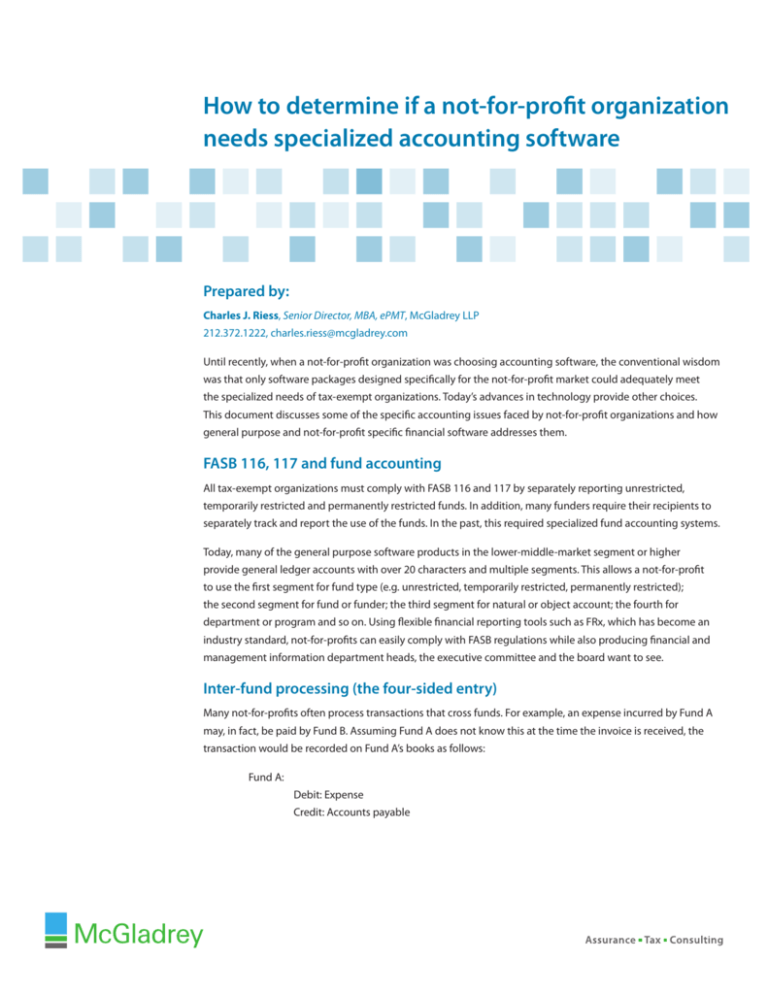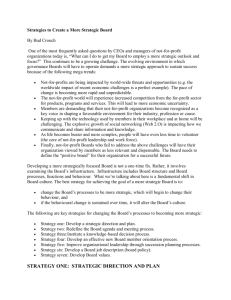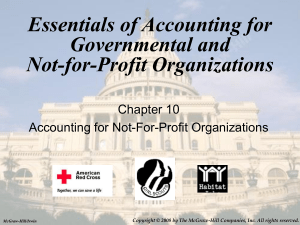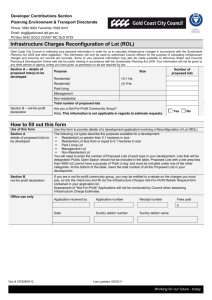
How to determine if a not-for-profit organization
needs specialized accounting software
Prepared by:
Charles J. Riess, Senior Director, MBA, ePMT, McGladrey LLP
212.372.1222, charles.riess@mcgladrey.com
Until recently, when a not-for-profit organization was choosing accounting software, the conventional wisdom
was that only software packages designed specifically for the not-for-profit market could adequately meet
the specialized needs of tax-exempt organizations. Today’s advances in technology provide other choices.
This document discusses some of the specific accounting issues faced by not-for-profit organizations and how
general purpose and not-for-profit specific financial software addresses them.
FASB 116, 117 and fund accounting
All tax-exempt organizations must comply with FASB 116 and 117 by separately reporting unrestricted,
temporarily restricted and permanently restricted funds. In addition, many funders require their recipients to
separately track and report the use of the funds. In the past, this required specialized fund accounting systems.
Today, many of the general purpose software products in the lower-middle-market segment or higher
provide general ledger accounts with over 20 characters and multiple segments. This allows a not-for-profit
to use the first segment for fund type (e.g. unrestricted, temporarily restricted, permanently restricted);
the second segment for fund or funder; the third segment for natural or object account; the fourth for
department or program and so on. Using flexible financial reporting tools such as FRx, which has become an
industry standard, not-for-profits can easily comply with FASB regulations while also producing financial and
management information department heads, the executive committee and the board want to see.
Inter-fund processing (the four-sided entry)
Many not-for-profits often process transactions that cross funds. For example, an expense incurred by Fund A
may, in fact, be paid by Fund B. Assuming Fund A does not know this at the time the invoice is received, the
transaction would be recorded on Fund A’s books as follows:
Fund A:
Debit: Expense
Credit: Accounts payable
However, when Fund B pays the item, a four-sided entry is created as follows:
Fund A:
Debit: Accounts payable
Credit: Due to Fund B
Fund B:
Debit: Due from Fund A
Credit: Cash
When Fund A reimburses Fund B, a corresponding four-sided entry would be created.
This inter-fund capability is often the cornerstone of fund accounting systems specific to not-for-profits. Some
of the middle-market, general-purpose accounting systems can handle this as an inter-company transaction,
but most cannot do this as an automatic inter-fund transaction within a single general. Some have third-party,
add-on products for this purpose while others do not. Most of the high-end products have this capability in
optional public sector or government modules. Therefore, if this capability is important to your organization,
look very carefully at the software packages you are evaluating. In most cases, for small- and middle-market
organizations, products specific to not-for-profits do a better job with inter-fund processing.
Grants management and project or contract accounting
Many not-for-profits receive grants, manage projects and are reimbursed under contracts. In fact, some
organizations have grants that fund multiple projects, as well as projects that are funded by multiple grants.
Often, the funder requires reports at a level of detail or in a format different from that used by the recipient
organization for internal reporting and management reporting.
One option for doing this is using a long chart of account numbers with the three segments listed above
(fund type, fund and natural account) plus three additional segments to identify the grant, project and cost
codes. This method has a drawback though. If the grant or project year is different from the organization’s
fiscal year or spans multiple years, the revenue and expense accounts for the grant or project must be closed
out each fiscal year. This makes grant or project-to-date and cross-fiscal year reporting more difficult (but not
impossible, because products such as FRx can put data from multiple fiscal years on a single report).
An alternative approach with general purpose accounting software is to use project or cost accounting
modules. Most of the products, including some in the small business category, offer this capability. Although
most project or cost accounting modules offer comprehensive capabilities, sometimes they have more
features than are needed and users find them difficult to implement and cumbersome to use. The software
products specific to not-for-profits generally are designed to handle the grant or project accounting
requirements and some also have specific features to aid in grants management (such as grant proposal
tracking, reporting requirements, etc.). Therefore, if grants management and project or contract accounting are
important to your organization, look carefully at all the alternatives.
Encumbrances
We have found the term encumbrance used in many ways. Some organizations want their encumbrance
system to alert them during purchase requisition or purchase order entry if budgeted funds are not available.
Others want a warning for requisitions but a rejection or hold for purchase orders that exceed available funds.
Some organizations, including most government agencies, want the committed funds (typically requisitions
2
are not considered committed and purchase orders are) to be posted to the general ledger or an encumbrance
ledger. Other clients want to see encumbrances on reports only, but not posted in the general ledger.
Most small business or middle-market accounting software products do not handle these types of
encumbrances out of the box. Some of the middle-market packages have third-party encumbrance modules
or optional requisition modules that provide a budget check during requisition entry, but few provide budget
checking during purchase order entry and very few post commitments to a ledger. Some of the high-end
products have optional modules for commitment accounting.
Most of the accounting software products specific to not-for-profits do not have requisition or purchase
order processing and do not provide encumbrance capabilities either. Therefore, when you are researching
encumbrance software, you must be very specific about what you are looking for and very diligent in
determining if the products under consideration provide the capabilities directly from the vendor’s offerings or
if third-party modules or customizations are required.
Budgeting
Some larger not-for-profit organizations have an extensive budget preparation process in which budget
worksheets are created by the controller’s or budget director’s office and distributed to department heads.
The departments prepare their budgets, often route them for approval and then return them to the controller
or budget director for review, analysis and roll up into the corporate budget. These capabilities are often
found in advanced budgeting modules offered by the upper-middle-market or high-end accounting software
products. Most accounting products for not-for-profits do not offer these capabilities. Another issue is tracking
budget modifications. Once the board-approved budget is finalized in some organizations, every change
(modification) to it must be tracked by date, reason and approver. In this case, many products for not-forprofits do possess this capability while the general purpose accounting systems do not.
Allocations
Some not-for-profits have sophisticated methods for allocating revenue and expenses. Some organizations
have multi-level step-down allocations in which the result of one allocation becomes the input into another.
Most of the middle-market, general purpose accounting systems provide single-level allocations within the
general ledger, but few possess multi-level capabilities. Some have optional advanced allocation modules
that provide these capabilities. Many clients prefer to do the allocations in spreadsheets. Using today’s
technologies, spreadsheet-based allocations can be directly linked with the middle-market (and higher)
products. In this way, data in the accounting system may be fed to a spreadsheet to be used in the allocation
calculations, and the results fed back to the accounting system without any re-keying along the way. Some
of the higher-end accounting products for not-for-profits have allocation features built in, but usually the
spreadsheet integration is weaker than that offered by the general purpose products.
Another important point to consider is that if your organization needs the project accounting, advanced
budgeting and advanced allocation features to be integrated, look very carefully. Many systems either do not
provide all these features or do not integrate well.
Purchasing, inventory and order processing
Many not-for-profits have substantial purchasing and inventory management needs and some sell products,
as well. For the most part, the general purpose accounting systems, from the small business market and
up, offer more robust purchasing, inventory and customer order processing capabilities than the not-for3
profit products. Therefore, if your organization wants to integrate these distribution functions with the core
accounting system (accounts payable, accounts receivable and general ledger), the general-purpose software
packages generally provide more capabilities than the not-for-profit packages.
Enterprise ready
Finally, if your organization is ready to adopt an enterprise resource planning (ERP) approach (see related white
paper: Enterprise resource planning for not-for-profits), the general purpose accounting systems typically
provide a better foundation to do so. In addition to the issue discussed earlier, most of the middle-market
and high-end accounting products have integrated customer relationship management (CRM) and business
intelligence solutions, and are generally far ahead of the not-for-profit products in providing e-business
capabilities.
Your decision
Every organization is different. Today’s technologies offer not-for-profits a much wider array of choices than
previously available. Before selecting a new accounting system, each organization must carefully evaluate its
short- and long-term needs as well as its budget, and then using the criteria detailed earlier, evaluate how well
the candidate software packages in the budget range meet the needs.
4
800.274.3978
www.mcgladrey.com
McGladrey LLP is the U.S. member of the RSM International (“RSMI”) network of independent accounting, tax and consulting firms.
The member firms of RSMI collaborate to provide services to global clients, but are separate and distinct legal entities which cannot
obligate each other. Each member firm is responsible only for its own acts and omissions, and not those of any other party.
McGladrey, the McGladrey signature, The McGladrey Classic logo, The Power of Being Understood, Power Comes from Being Understood
and Experience the Power of Being Understood are trademarks of McGladrey LLP.
© 2012 McGladrey LLP. All Rights Reserved.









